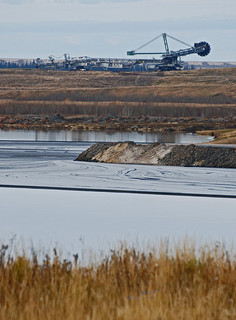Today 36 Norwegian organizations sent an open letter to Prime Minister Stoltenberg expressing opposition to development of Canadian tar sands by Statoil (the Norwegian state is majority shareholder of Statoil).
Signatories include not only environmental organizations, but a broad public spectrum, including, appropriately, many youth organizations. It is encouraging that Norwegian youth press their government to stop supporting tar sands development, given the fact that Norway saves much of its oil earnings for future generations and given the fact that Norway is not likely among the nations that will suffer most from climate change.
I wonder if the Norway government response will be better than their response in 2010. The gap between public preference and government policy is not unique to Norway.
Similar situations were found in other nations, as described in Storms of My Grandchildren. Governments talk green while doing black, supporting or even subsidizing the fossil fuel industry while doing little to solve fossil fuel addiction.
The Canadian public is also impressive. Most messages that I receive from Canadians are ones of encouragement, apologetic that some government ministers speak out of both sides of their mouth at the same time. On one hand, they say that tar sands will make Canada the Saudi Arabia of oil. On the other hand, they say that the amount of carbon in tar sands is negligible.
The truth is that the tar sands gook contains more than twice the carbon from all the oil burned in human history. If infrastructure, such as the Keystone XL pipeline, is built to transport tar sands gook, ways will be developed to extract more and more. When full accounting is done of emissions from tar sands oil, its use is equivalent to burning coal to power your automobile. This is on top of the grotesque regional tar sands destruction.
There is a basis for optimism that the Keystone pipeline can be stopped and tar sands exploitation phased down before it becomes the monstrosity that oil companies are aiming for. Tar sands make no economic sense if fossil fuels pay their true costs to society via a gradually rising fee collected from fossil companies in proportion to the amount of carbon in the fuel.
Conservatives in the United States are beginning to recognize the merits of a carbon fee, which would be a non-tax, 100 percent of collected funds distributed to the public on per capita basis. The Wall Street Journal recently published an article endorsing this approach by George Shultz and Gary Becker, a Nobel prize winning economist. Such a fee levels the playing field among alternative energies and energy efficiency, providing a spur for development of clean energies.
After 10 years a carbon fee rising $10 per ton of CO2 per year would reduce United States carbon emissions by 10-11 times more than the carbon carried by the Keystone pipeline. The funds distributed to the public, 60 percent of the people getting more than they pay in increased prices, would spur the economy. The energy revolution would create millions of jobs.
So don’t despair re: the tar sands. There are sensible alternatives.
The common presumption that President Obama is going to approve the Keystone XL pipeline is wrong, in my opinion. The State Department must provide an assessment to President Obama. Secretary of State John Kerry is expert on the climate issue and has long been one of the most thoughtful members of our government. I cannot believe that Secretary Kerry would let his and President Obama’s legacies go down the tar sands drain.
Dr. James Hansen is director of NASA’s Goddard Institute for Space Studies and adjunct professor in the department of earth and environmental sciences at Columbia University. He was the first scientist to warn the US Congress of the dangers of climate change and writes here as a private citizen. Hansen is the author of “Storms of My Grandchildren: The Truth About the Coming Climate Catastrophe and Our Last Chance to Save Humanity.“
This piece was originally posted on Dr. James Hansen’s page at the Columbia University Earth Institute.
Photo: NWFblogs/ Flickr



